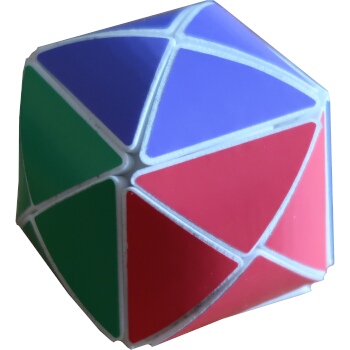|
A Little Chop with two additional restrictions which transform the puzzle into the equivalent of the M24 Group, one of the sporadic groups.
This puzzle appears to be a 24-cube or Little Chop. Indeed it allows the turns of that puzzle but it has two additional restrictions which transforms it into the mechanical equivalent of M24, which is one of the 26 sporadic groups. The mechanism is probably simpler that one would expect. It uses a similar technique to the Alternating Cube (see the separate entry) and the Alternating Asynchronous Antislice Face Turning Octahedron (see the separate entry) from the same inventor. The basic idea is that there are toggles on the inside that are driven by some subset of the axes. There are four toggles in this one, one driven by all axes and one for each pair of axes that point in the same direction. The three pair toggles are one one layer and the full toggle is on a layer by itself. Image 3 shows the core of the puzzle with one for the pair toggles in it alongside the pair toggle by itself. Image 4 shows the assembled mechanism alongside the two types of axes showing how the drive the toggles. Not surprisingly, there are a lot of neat properties of the positions of this puzzle. The unrestricted (super) 24-cube has 24!/2 = 310,224,200,866,619,719,680,000 positions while this puzzle has only 244,823,040. If you ignore rotations and recolourings, these numbers become 4,509,264,634,875 and 5,100,480. There are only 2 solved positions of this puzzle: the original colour scheme and its reflected image. There are a lot of different colouring schemes of this puzzle that show off different properties of this group. For example a 3-colouring with a colour for each direction a long edge of a piece can point that gives the trio subgroup, and show a 6-colouring (a refinement of the 3-colouring that alternates 2 colours for each of the original 3 colours) that gives the sextet subgroup. The other maximal subgroups also have stickerings that give them, although the point subgroup is boring and the projective line subgroup is very confusing. The shape is the Steinmetz solid, a combination of three cylinders. Contributors
No one has contributed to this page yet! Collections No one has added this puzzle to a collection yet! Found a mistake or something missing? Edit it yourself or contact the moderator. |
|




